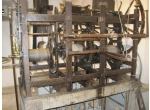Siete qui:
- Home
- The Maurizio Tower
The Maurizio Tower
The Maurizio Tower (Torre di Maurizio) is rightly one of Orvieto's symbols. In fact, its clockwork mechanism consisting of a timekeeping device to which an automaton is attached by way of a pin which allows the automaton to turn to its side and strike the time each hour on the hour, is the most ancient documented clockwork automaton still existing and operating in the present day.
Its history is strictly related to the history of the Duomo and, if in the local imagination, but not only, "Maurizio" has been associated with the small bearded man striking the bell with a hammer, the tower name has really nothing to do with that funny time-keeper. In fact it is nothing but a dialectal transformation of the Latin word "muricium" that is a masonry building and, as a wider meaning, a worksite. And in fact, this ariologium de muricio, was built at the behest of the Opera del Duomo between 1347 and 1348, to support the Cathedral worksite. It is interesting to notice that all this was done, with great activism and desire for revenge, just when the black plague was devastating Europe, as if to enhance, even in difficult times, the human need for forward thinking. There were two main purposes for its construction: on one hand, the beauty of this ornament, and its usefulness on the other, as the clock had to regularly indicate start and end times of the daily shifts for the many workers employed on the Cathedral site. This task seems obvious at present day, but it was a real revolution in those ages as the Medieval concept of time had been very imprecise up to that point. But people employed on the worksite had to be paid according to a common reference base, therefore they all had to work the same number of hours, and attendance as well as delays, had to be recorded: this latter task being carried out by the Treasurer of the Opera del Duomo who was also in charge of paying the weekly wages.
The peculiarity of that timekeeping system was also due to another reason: the automatisms did not move angels, roosters or other characters distant from the specific context like previous medieval clocks had done, but a character that fitted in perfectly well with the rest, a worker, possibly very similar to those employed at the worksite; and the jaquemart looks like a real working class representative, his features being less refined than those of the bronze statues of the facade, that were cast in 1325. Two inscriptions – one along the belt worn by the automaton, the other on the bell crown – complete this interaction, thereby creating a funny exchange. If the bell striker, the then famous Maurizio, would glorify his role by saying "Da te a me, campana, furo i pati: tu per gridar et io per far i fati", (between you and me, bell, let's make a pact: you are here to cry out and I am here to act) the bell would answer back, calmly and ironically, :"Se vuoi ch'attenga i pati, dammi piano. Se no io cassirò e darà invano" (If you wish me to respect the pact, hit me softly, or I will break and you will have hit me in vain) hereby reaffirming the need for mutual help.
The clockwork mechanism that currently moves the Maurizio, dates back to the eighteenth century, when, amongst other things, a countwheel was added to strike the quarters on the smaller bells; other adjustments were carried out between 1860 and 1870 and in 1905, when the automaton headgear was also replaced.
People can go up to the very top of the tower only in exceptional circumstance (by way of example, on the days dedicated to the FAI, the Italian Environment Fund, or during the Culture Week). Thanks to a webcam, the clockwork mechanism and its contraptions can be viewed on a screen located in the tower entrance.









